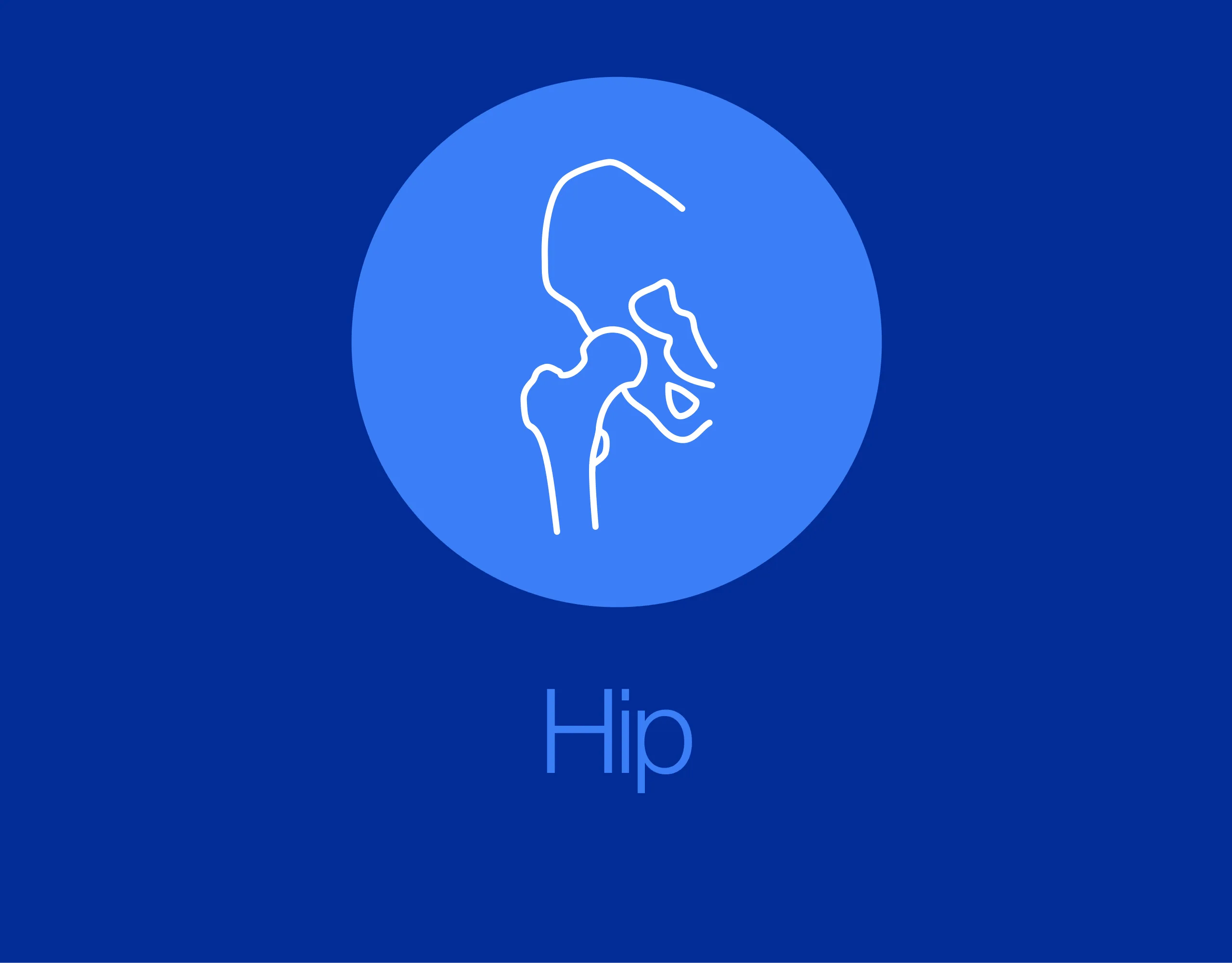ORIF through ilioinguinal approach
1. General considerations
Sequence of the treatment
For ORIF of anterior wall fractures with ilioinguinal approach, the following surgical sequence is common:
- Joint distraction and removal of incarcerated fragments
- Reduction of femoral head dislocation if not achieved closed on admission
- Reduction of marginal impaction (indispensable part of the sequence)
- Reduction of anterior wall
- Assessment of reduction (the anterior wall reduction is using extraarticular keys)
- Fixation of the anterior wall fragment with interfragmentary screws and a neutralization plate
Planning/templating
Preoperative templating is essential for understanding the complexity of an acetabular fracture.
When using implants on the innominate bone, it is important to know the best starting points for obtaining optimal screw anchorage (see General stabilization principles and screw directions).
Patient positioning
This procedure is normally performed with the patient in a supine position.

Blood supply
Blood supply to the anterior wall fracture fragments can be tenuous. Remaining soft-tissue attachments should be preserved.
Indirect visualization
Unusually for a significant joint, articular reduction of acetabular fractures is indirect. The articular surface of the hip joint is not seen directly. Reduction must be assessed by the appearance of the extraarticular fracture lines and intraoperative fluoroscopic assessment. Some fracture lines are palpated manually but not seen directly such as transverse fracture lines on the quadrilateral plate.
Quality of reduction
Posttraumatic arthrosis is directly related to the quality of reduction - the better the reduction, the greater the chance of a good or excellent result.
2. Joint distraction
Application of traction
It is important to ensure hip flexion to allow enhanced exposure of the iliac fossa and true pelvis.
The anterior wall fracture is a result of displacement or dislocation of the femoral head at the time of injury. In order to allow manipulation of the anterior wall fracture, the femoral head must be distracted. This is typically accomplished with the application of lateral and/or distal traction.
In some surgeon’s experience, the use of a traction table post or other traction frame is helpful during this operation.
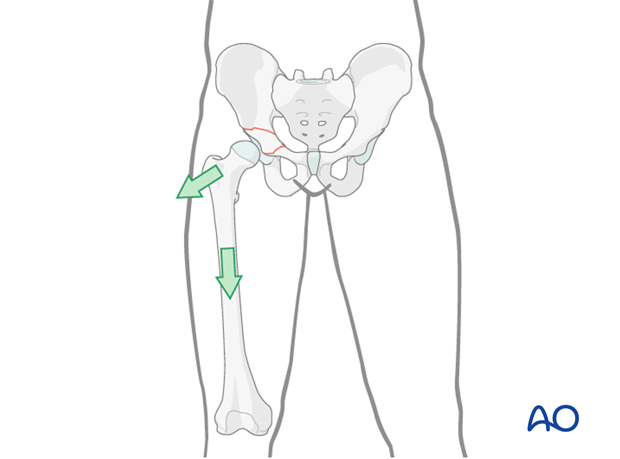
Center the femoral head under the radiological roof using a combination of lateral traction, distal/longitudinal traction, and limb positioning.
Verify the femoral head reduction with the image intensifier.
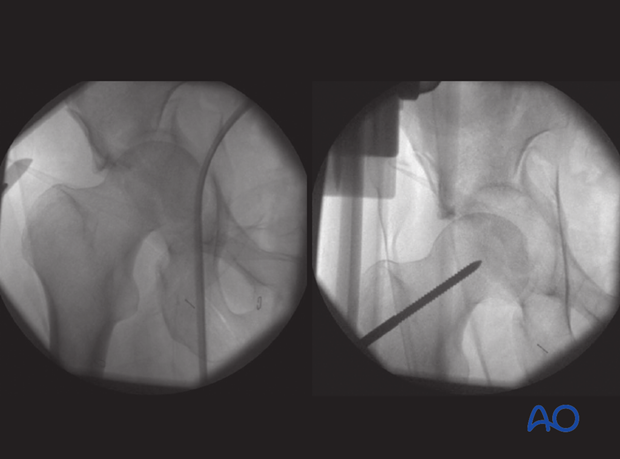
Lateral traction with a trochanter screw
Traction may be applied through a Schanz screw in the greater trochanter, manually or attached to a fracture table.
Insert the screw along the axis of the femoral neck, through a short, separate incision over the greater trochanter.

Longitudinal traction
Longitudinal traction may be applied in the axis of the femur. This can be accomplished manually via a distal femoral traction pin or via a fracture table.
Alternatively, a large distractor may be applied using the following technique.
Insert the proximal 5 mm Schanz screw in the sciatic buttress placed from anterior to posterior.
Place the distal Schanz screw into the femur at the level of the lesser trochanter from anterior to posterior. Attach the distractor as shown to these two screws.
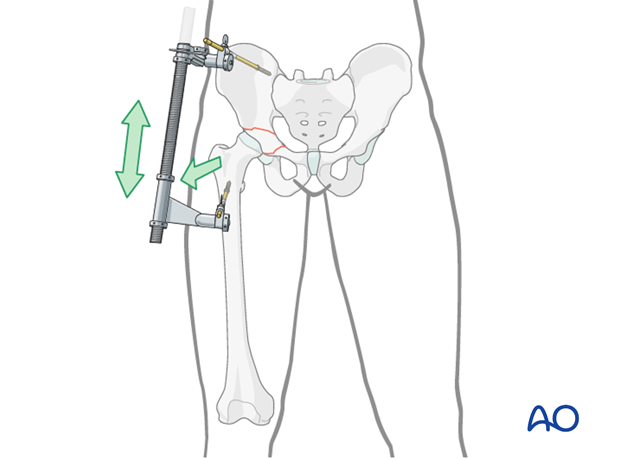
Teaching video
AO teaching video: Use of the distractor on the pelvis
3. Cleaning of the fracture site
Clean and irrigate the fracture site in preparation for the direct reduction.
Localize, remove, and/or clean and reinsert any free intraarticular fracture fragments.
4. Reduction of marginal impaction
Marginal impaction of the acetabular roof articular cartilage is commonly associated with fractures of the anterior wall or column, particularly in elderly patients.
This marginal impaction must be anatomically reduced and stabilized to optimize outcome.
Unlike fractures of the posterior wall, these areas of impaction cannot be directly visualized. Instead, the reduction of these regions requires fluoroscopic guidance.
On the plain film, one can see the femoral head remains congruent with the displaced anterior wall or column. There is an area of marginal impaction which has been impacted into the intact posterior column. The intact portion of the acetabulum remains in its native location laterally.
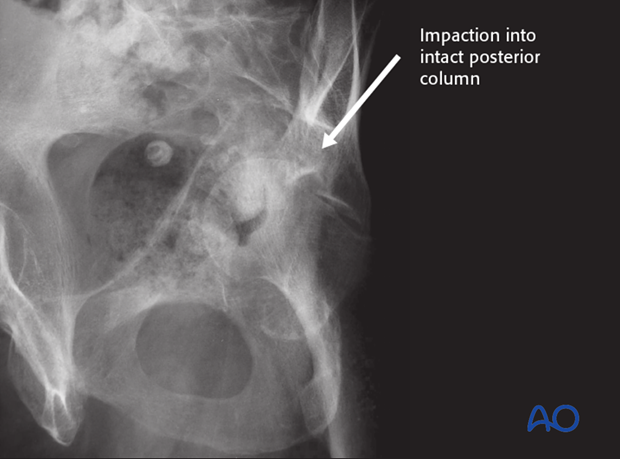
The CT scan demonstrates that the femoral head remains congruent with the anterior wall or column fragment. The quadrilateral surface has hinged around its posterior margin. The area of marginal impaction is seen to be impacted into the posterior column. Importantly, the intact portion of the acetabular roof is seen to cause and impaction injury to the femoral head.
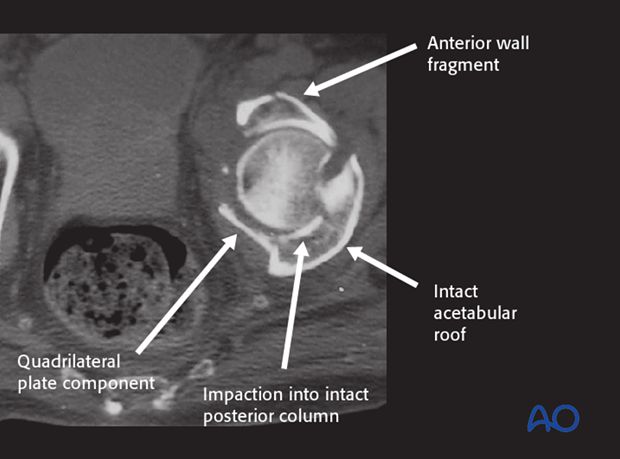
Reduction of this impaction is performed by working through the fracture, or alternatively, through a cortical window created in the ilium.

In either case, the fluoroscopy guides the manipulation and definitive reduction of the impacted segment.
In this example, the osteotome is placed through the fracture.
The area of impaction is mobilized and contoured utilizing the femoral head as a template.
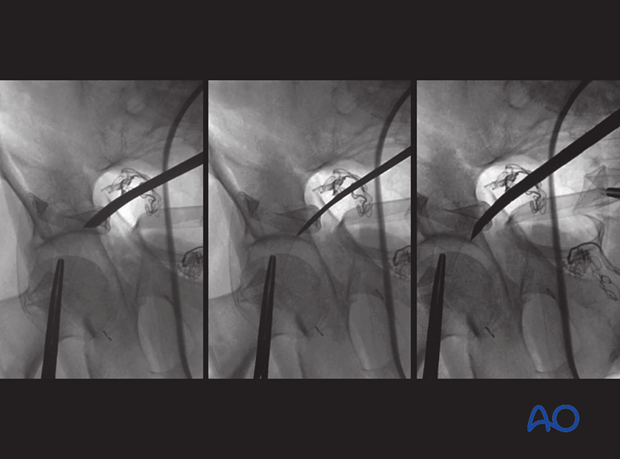
Once the reduced articular surface is in its original position, the defect is filled with cancellous autograft or a bone substitute.
After articular impaction has been addressed, one can proceed with fracture reduction.

5. Reduction and preliminary fixation
Reduction of the anterior wall fragment
The anterior wall fragment reduction is remarkably difficult. The external surface of the fragment is almost entirely articular cartilage, therefore adjuncts such as screws or joysticks threaten the joint surface.
- It is difficult to apply Schanz screws, as there is very little extraarticular ilium available.
- Screw based reduction clamps are precluded as bicortical screws in the anterior wall fragment threaten the articular surface. Unicortical screws may be used, however, pull out is a risk.
Unicortical adjuncts, hooks, ball spike pushers and carefully applied clamps are utilized to manipulate the fragments. In this example, K-wires have been placed unicortically to manipulate the fracture fragment.

Various clamps can be utilized to attempt reduction of the anterior wall fragment to the quadrilateral surface/posterior column.
- The angled jaw clamp can be applied as shown (left), with the internal point applied to the quadrilateral surface or posterior column. The superficial point is applied to the anterior surface of the fragment lateral to the pelvic brim. This clamp can be applied from the second window over the pelvic brim.
- Alternatively, a pointed reduction forceps (right) may be applied similarly. Due to the difference in geometry, this clamp may require placement from the modified third window (modified Stoppa interval).

An offset pelvic reduction forceps with pointed ball tips may be applied between the quadrilateral surface and the unbroken pelvis to reduce the wall fragment.
One point is placed on the quadrilateral plate surface, while the other is placed on the external surface of the bone just lateral to the anterior inferior iliac spine.
In osteoporotic bone, a pointed washer may be used on top of the pointed ball tips to prevent perforation.
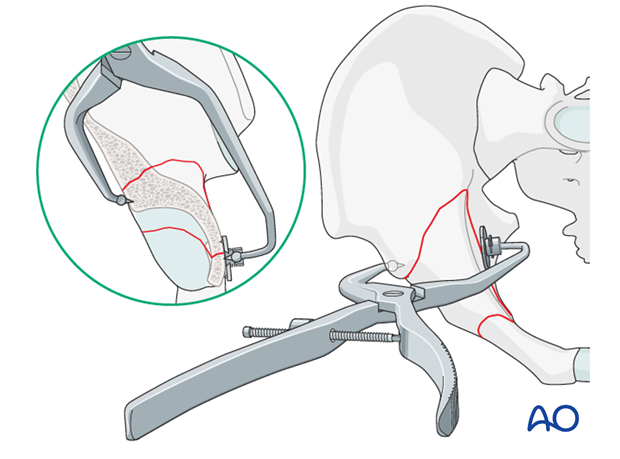
Often, multiple points are required for mobilization and provisional stabilization of the fragment.
In this example, the unicortical K-wires are used as joysticks. The angled jaw clamp has been applied to control the medial reduction of the fragment to the quadrilateral surface/posterior column. The offset pelvic reduction forceps has been placed from the outer ilium to the apex of the fragment, generating compression into the ilium.
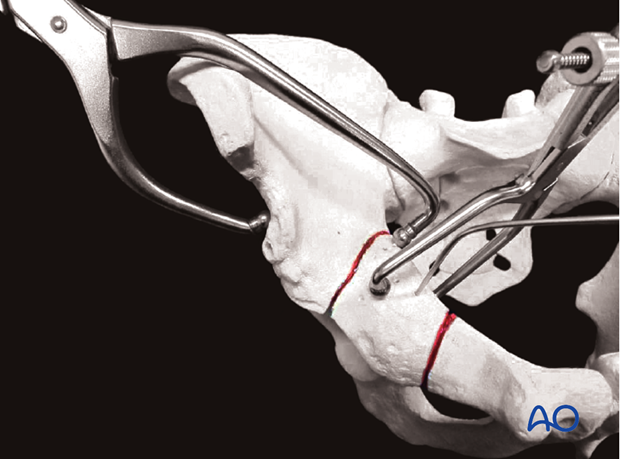
Ball spike pusher
A ball spike pusher is used in combination with clamps to control rotation of the fragment, and maintain reduction until definitive fixation.
Note
Since the ilioinguinal approach does not allow visualization of the joint surface, the reduction is determined to be anatomical by the cortical reduction, by image intensifier control, and by palpation of the internal aspect of the innominate bone.
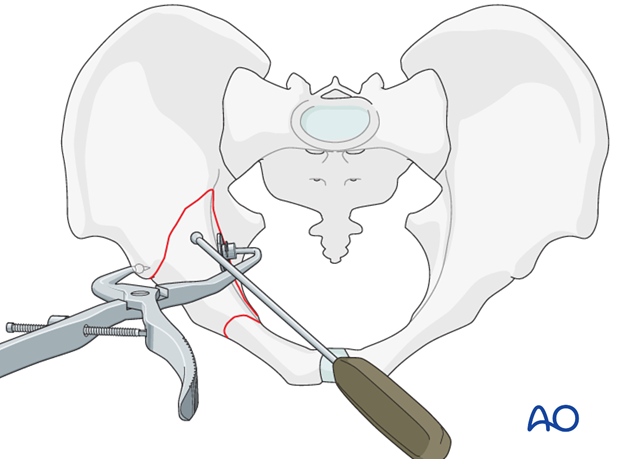
Preliminary fixation
If the fragment is large enough, K-wires may be placed to allow provisional fixation.
These wires are applied through the second or modified third window and directed distal to proximal. Note the trajectory required to avoid perforating the articular surface.
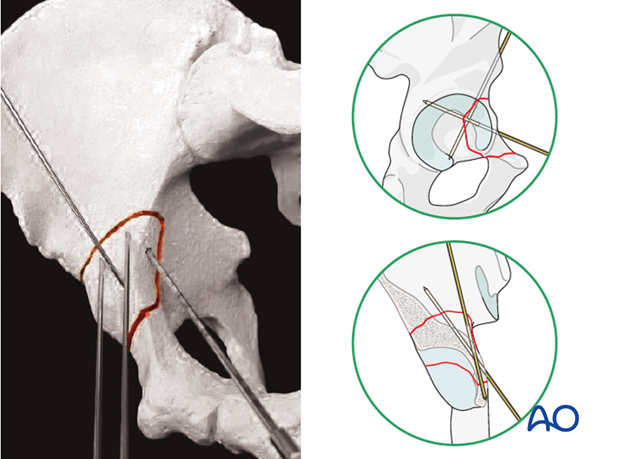
6. Definitive fixation
Isolated interfragmentary screws
Based on the juxtaarticular nature of the small anterior wall fragment, interfragmentary screws may not be possible without violating the articular surface.
When there is sufficient cranial bone, an interfragmentary screw may be possible. The screw is typically started just lateral to the pelvic brim and directed into the sciatic buttress.

A distal interfragmentary screw may be necessary parallel to the quadrilateral surface. This screw may be exposed within the cotyloid fossa on the external surface. It is important to recognize this and ensure the screw not be in a position to articulate with the femoral head. This screw should be used with extreme caution.
Isolated lag screw placement does not provide adequate fracture stability.
Lag screw placement should not disturb optimal plate positioning.
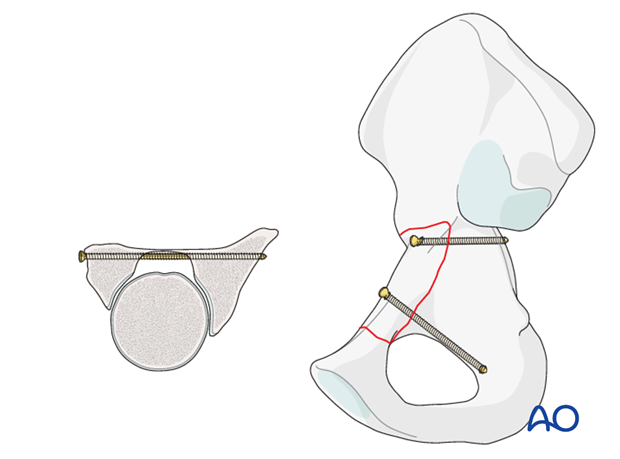
Application of neutralization plate
Neutralize the reduced fracture with a precontoured small fragment pelvic reconstruction plate applied to the anterior surface of the anterior column, just medial to the pelvic brim.
The plate bridges the reduced fragment and extends superiorly to the inner part of the iliac fossa in front of the sacroiliac joint.
Inferiorly it extends to the intact part of the superior pubic ramus and the body of the pubis.
At least two screws are placed on each side of the fracture. Interfragmentary lag screws may be possible through the plate. However, these screws commonly risk the underlying articular surface and may be impossible.
Every screw should be placed extraarticularly.
Note
In case of osteoporotic bone adequate anchorage of the neutralization plate is only obtained by the use of very long screws near the SI joint and the symphysis pubis.
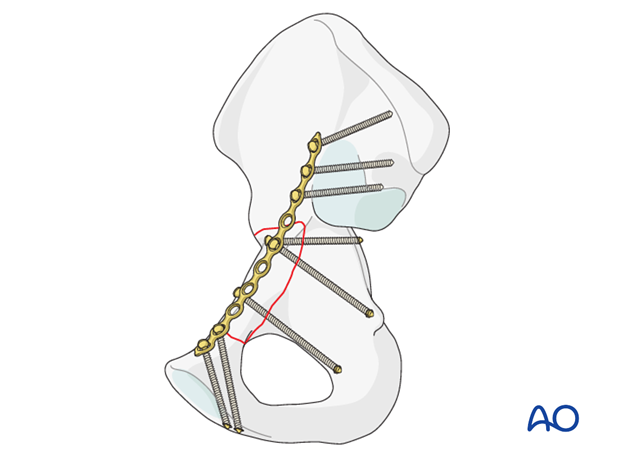
Additional fixation
Many anterior wall cases involve very small fragments or are multi-fragmentary. In these cases, particularly if interfragmentary fixation is not possible, additional small fragment plates may be required to add stability.
In this example, a second small fragment plate is applied peripherally to aid in torsional stability. Remember that the screws placed into the anterior wall fragment risk violating the articular surface. Unicortical or locked screws may be required. In this example, the plate is placed in buttress mode to avoid any screw placement into the fracture fragment.
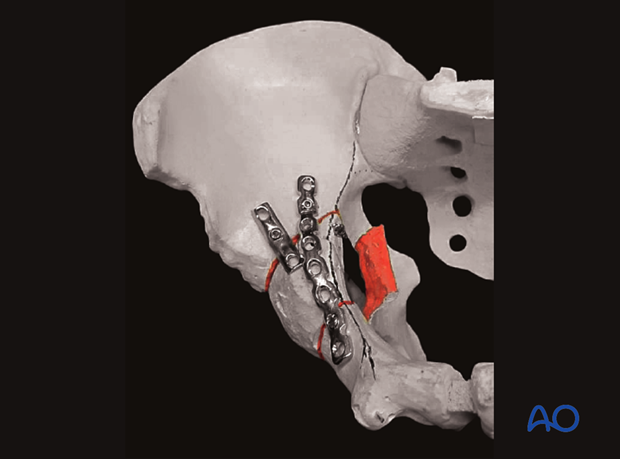
Quadrilateral surface stabilization
In anterior wall fractures that involve a large quadrilateral surface fragment, it may be necessary to reduce and stabilize this fragment.
The fragment may be reduced with an angled jaw clamp placed over the pelvic brim as demonstrated. This clamp is typically placed through the second window, and must be carefully applied to avoid inappropriate tension on the external Iliac artery and vein.
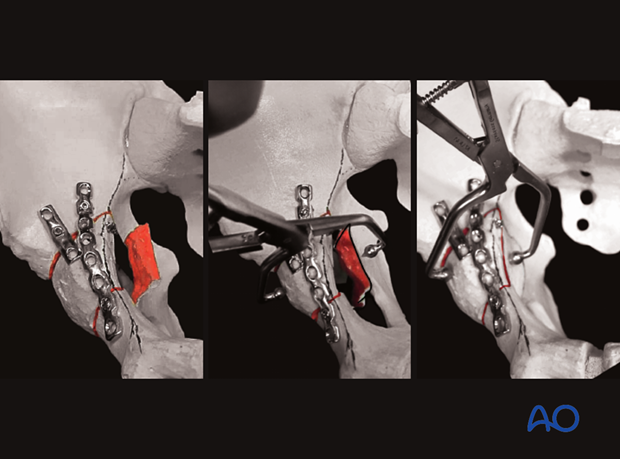
Alternatively, the quadrilateral surface fragment may be addressed with a ball spike pusher (or other push device) applied via the modified third window (modified Stoppa interval).
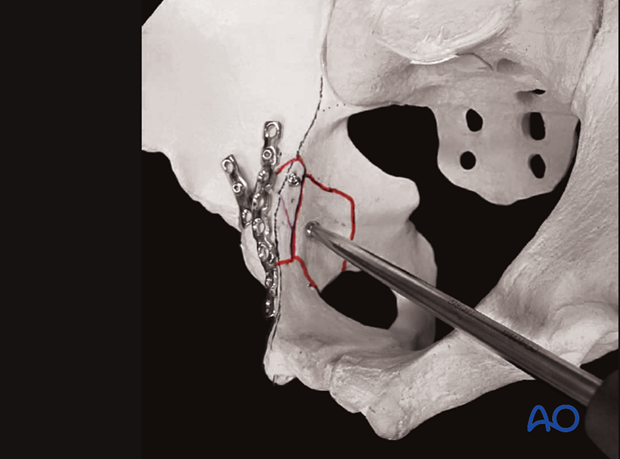
The quadrilateral plate is commonly stabilized with an infrapectineal plate applied via the modified third window (modified Stoppa interval). There are many different plates and fixation configurations available to address the quadrilateral surface fracture fragment. Most commonly, these plates are undercontoured to apply a lateralizing/buttressing effect to the quadrilateral surface.
In this example, the plate is secured above the articular surface proximally, and undercontoured to provide a lateralized push on the quadrilateral surface.

7. Radiographic assessment
Intraoperative radiographic assessment
Confirm fracture reduction with AP, iliac and obturator oblique fluoroscopic images.
The position of all screws should be assessed, particularly those close to the acetabulum. An image centered over a screw and aimed along its axis is the best way to ensure that it does not enter the hip joint.
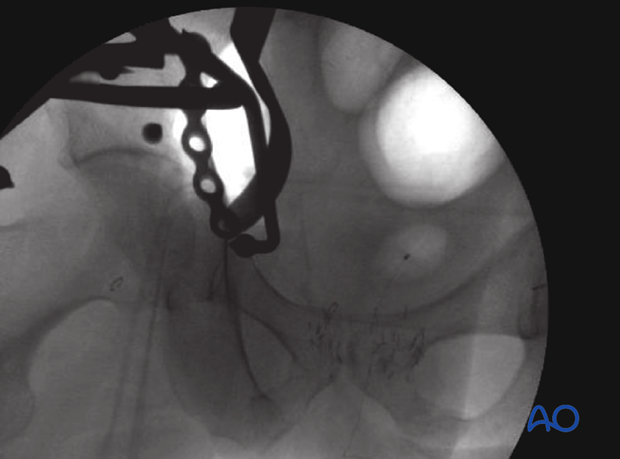
Final radiographic assessment
The final AP, obturator oblique and iliac oblique radiographs demonstrate:
- Concentric reduction of the femoral head with respect to the intact region of the acetabular roof.
- The reduction and stabilization of the anterior wall component
- The reduction, rafting, and graft stabilization of the reduced marginal impaction.
- The reduction and stabilization of the quadrilateral plate fragment
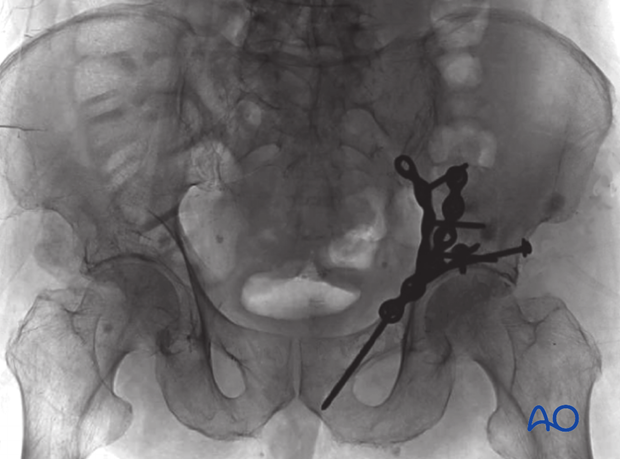
- The extraarticular nature of all periarticular screws (best seen on the obturator oblique; left)
Postoperatively, obtain formal high quality radiographs of AP and both oblique views.
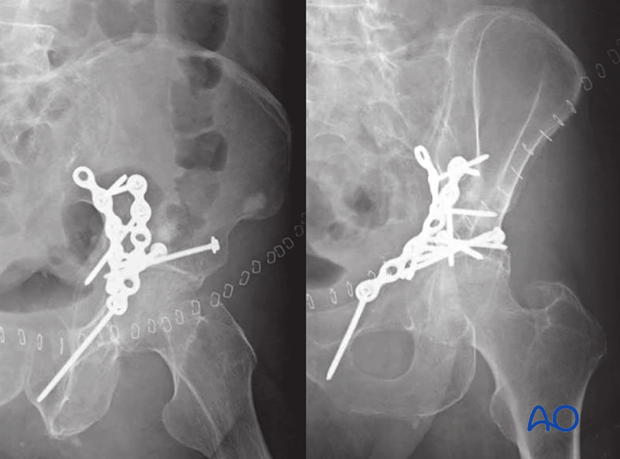
8. Wound closure
Before closure, one may place drains in the space of Retzius and anterior internal iliac fossa.
Layered closure then begins with repair of the conjoint tendon to the distal inguinal ligament. A careful fascial repair restores the floor of the inguinal canal.
The external oblique aponeurosis and the rectus sheath are then repaired, followed by secure reattachment of the abdominal wall origin to the iliac crest, in the lateral portion of the incision. A hernia-free repair, and avoidance of entrapment of the spermatic cord should be achieved.
Subcutaneous drains may be inserted.
Finally, perform an appropriate subcutaneous and skin closure.
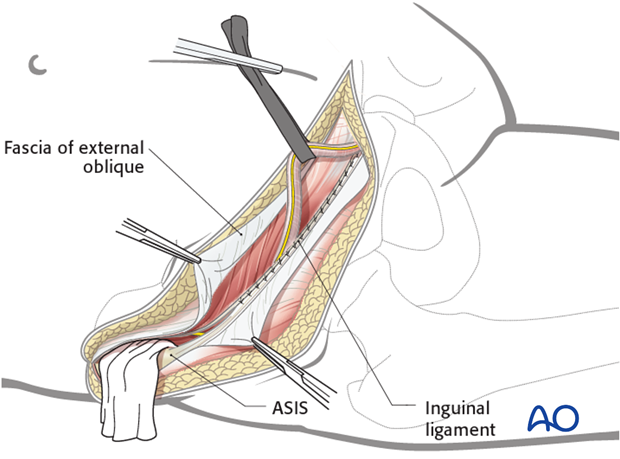
9. Postoperative care
During the first 24-48 hours, antibiotics are administered intravenously, according to hospital prophylaxis protocol. In order to avoid heterotopic ossification in high-risk patients, the use of indomethacin or single low dose radiation should be considered. Every patient needs DVT treatment. There is no universal protocol, but 6 weeks of anticoagulation is a common strategy.
Wound drains are rarely used. Local protocols should be followed if used, aiming to remove the drain as soon as possible and balancing output with infection risk.
Specialized therapy input is essential.
Follow up
X-rays are taken for immediate postoperative control, and at 8 weeks prior to full weight bearing.
Postoperative CT scans are used routinely in some units, and only obtained if there are concerns regarding the quality of reduction or intraarticular hardware in others.
With satisfactory healing, sutures are removed around 10-14 days after surgery.
Mobilization
Early mobilization should be stressed and patients encouraged to sit up within the first 24-48 hours following surgery.
Mobilization touch weight bearing for 8 weeks is advised.
Weight bearing
The patient should remain on crutches touch weight bearing (up to 20 kg) for 8 weeks. This is preferable to complete non-weight bearing because forces across the hip joint are higher when the leg is held off the floor. Weight bearing can be progressively increased to full weight after 8 weeks.
With osteoporotic bone or comminuted fractures, delay until 12 weeks may be considered.
Implant removal
Generally, implants are left in situ indefinitely. For acute infections with stable fixation, implants should usually be retained until the fracture is healed. Typically, by then a treated acute infection has become quiescent. Should it recur, hardware removal may help prevent further recurrences. Remember that a recurrent infection may involve the hip joint, which must be assessed in such patients with arthrocentesis. For patients with a history of wound infection who become candidates for total hip replacement, a two-stage reconstruction may be appropriate.
Sciatic nerve palsy
Posterior hip dislocation associated with posterior wall, posterior column, transverse, and T-shaped fractures can be associated with sciatic nerve palsy. At the time of surgical exploration, it is very rare to find a completely disrupted nerve and there are no treatment options beyond fracture reduction, hip stabilization and hemostasis. Neurologic recovery may take up to 2 years. Peroneal division involvement is more common than tibial. Sensory recovery precedes motor recovery and it is not unusual to see clinical improvement in the setting of grossly abnormal electrodiagnostic findings.
